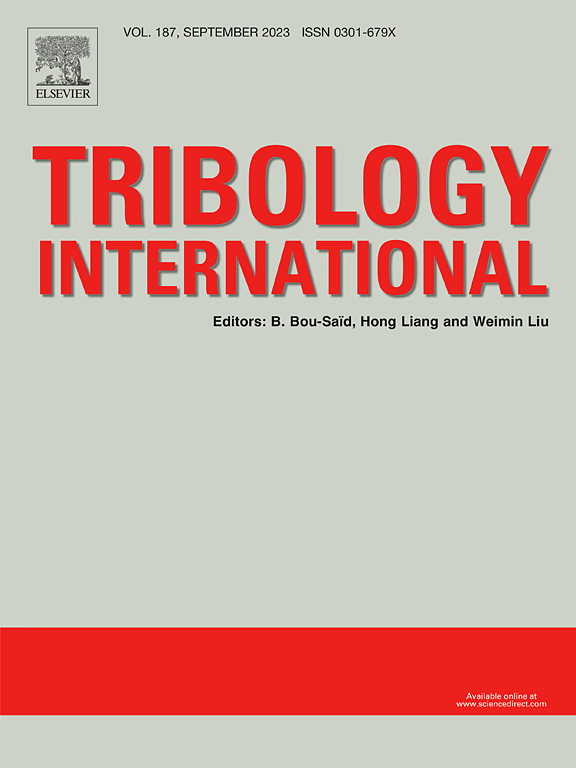Effect of Cr:C ratio on open three-body wear resistance of squeeze cast high chromium cast iron
IF 6.1
1区 工程技术
Q1 ENGINEERING, MECHANICAL
引用次数: 0
Abstract
A series of high chromium white cast iron (HCCI) alloys with varying Cr:C ratios were designed and fabricated through the squeeze casting process. This study investigates the effect of the Cr:C ratio on the mechanical properties, microstructure, phase diagram, and both low-stress and high-stress abrasion performance of HCCIs. Alloys with a very high Cr:C ratio exhibited better impact toughness but poorer hardness. Scanning electron microscopy (SEM) and phase diagram calculations elucidated the influence of the Cr:C ratio on microstructure, carbide volume fraction, and carbide type. Abrasion resistance was evaluated using impact abrasive wear (high-stress) and rubber-wheel (low-stress) abrasion on quartzite in open three-body wear. Comprehensive assessments under impact abrasive wear and rubber-wheel abrasive wear conditions suggest that the alloy achieves optimal abrasion resistance with a Cr:C ratio ranging from 8 to 11. Post-wear analysis reveals that surface damage varies between high-stress and low-stress conditions. The microstructure of squeeze HCCIs is significantly influenced by the Cr:C ratio, resulting in diverse operative wear mechanisms, including micro-cutting and micro-fracture. Successful adjustment of the Cr:C ratio led to the attainment of a nearly eutectic HCCIs composition suitable for squeeze casting.
Cr:C 比对挤压铸造高铬铸铁开口三体耐磨性的影响
通过挤压铸造工艺,设计并制造了一系列不同 Cr:C 比的高铬白口铸铁 (HCCI) 合金。本研究探讨了 Cr:C 比对高铬白口铸铁的机械性能、微观结构、相图以及低应力和高应力磨损性能的影响。Cr:C 比率非常高的合金具有更好的冲击韧性,但硬度较低。扫描电子显微镜(SEM)和相图计算阐明了 Cr:C 比率对微观结构、碳化物体积分数和碳化物类型的影响。在开放式三体磨损中,使用冲击磨料磨损(高应力)和橡胶轮(低应力)磨损对石英岩的耐磨性进行了评估。在冲击磨料磨损和橡皮轮磨料磨损条件下进行的综合评估表明,该合金在 Cr:C 比值为 8 到 11 时具有最佳耐磨性。磨损后分析表明,表面损伤在高应力和低应力条件下有所不同。挤压 HCCIs 的微观结构受到 Cr:C 比率的显著影响,从而产生了不同的磨损机制,包括微切削和微断裂。通过成功调整 Cr:C 比率,获得了适合挤压铸造的近共晶 HCCIs 成分。
本文章由计算机程序翻译,如有差异,请以英文原文为准。
求助全文
约1分钟内获得全文
求助全文
来源期刊

Tribology International
工程技术-工程:机械
CiteScore
10.10
自引率
16.10%
发文量
627
审稿时长
35 days
期刊介绍:
Tribology is the science of rubbing surfaces and contributes to every facet of our everyday life, from live cell friction to engine lubrication and seismology. As such tribology is truly multidisciplinary and this extraordinary breadth of scientific interest is reflected in the scope of Tribology International.
Tribology International seeks to publish original research papers of the highest scientific quality to provide an archival resource for scientists from all backgrounds. Written contributions are invited reporting experimental and modelling studies both in established areas of tribology and emerging fields. Scientific topics include the physics or chemistry of tribo-surfaces, bio-tribology, surface engineering and materials, contact mechanics, nano-tribology, lubricants and hydrodynamic lubrication.
 求助内容:
求助内容: 应助结果提醒方式:
应助结果提醒方式:


